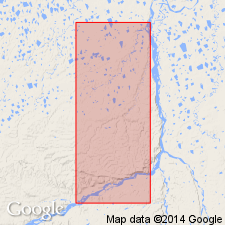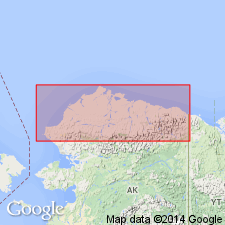
- Usage in publication:
-
- Barrow Trail member*
- Modifications:
-
- Original reference
- Biostratigraphic dating
- Dominant lithology:
-
- Sandstone
- AAPG geologic province:
-
- Alaska Northern region
Summary:
Pg. 246, 249, 250-251, fig. 5. Barrow Trail member of Schrader Bluff formation of Colville group. More than one-half the member at type locality is fine- to very fine-grained, light-gray to olive-gray, thick-bedded sandstone, in part bentonitic to tuffaceous. Interbedded with sandstone are clay shale, siltstone, bentonite, and tuff. Marine fossils found at five horizons from 40 feet to 525 feet above base. A minor nonmarine tongue of Prince Creek formation represented in this type section by a 2-foot coal bed about 170 feet above base. Thickness 575 feet in vicinity of Umiat, at least 700 feet and possibly as much as 900 feet at Schrader Bluff. Underlies Sentinel Hill member; overlies Rogers Creek member (new). Rogers Creek and Barrow Trail members defined to include rocks overlying Tuluvak tongue of Prince Creek formation that were formerly included in Tuluga member. Age is Late Cretaceous (late Santonian to early Campanian), based on fossils.
Type locality: bluffs along north side of Colville River, 3 to 5 mi northeast of Umiat Mountain, northern AK. Named from Barrow Trail, and old tractor trail which, in the area from 13 to 28 mi west of Umiat Mountain, follows cuesta formed by sandstones of this member.
Source: US geologic names lexicon (USGS Bull. 1200, p. 223); supplemental information from GNU records (USGS DDS-6; Menlo GNULEX).

- Usage in publication:
-
- Barrow Trail Member†
- Modifications:
-
- Abandoned
- AAPG geologic province:
-
- Alaska Northern region
Summary:
Pg. 5 (fig. 4), 6-8 (table 1), 26. †Barrow Trail Member of Schrader Bluff Formation of †Colville Group. Abandoned. (†Colville also abandoned.) Rocks reassigned to unnamed middle part of Schrader Bluff Formation. [See Schrader Bluff.]
Source: Publication.
For more information, please contact Nancy Stamm, Geologic Names Committee Secretary.
Asterisk (*) indicates published by U.S. Geological Survey authors.
"No current usage" (†) implies that a name has been abandoned or has fallen into disuse. Former usage and, if known, replacement name given in parentheses ( ).
Slash (/) indicates name conflicts with nomenclatural guidelines (CSN, 1933; ACSN, 1961, 1970; NACSN, 1983, 2005, 2021). May be explained within brackets ([ ]).

